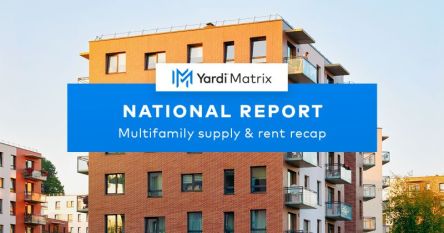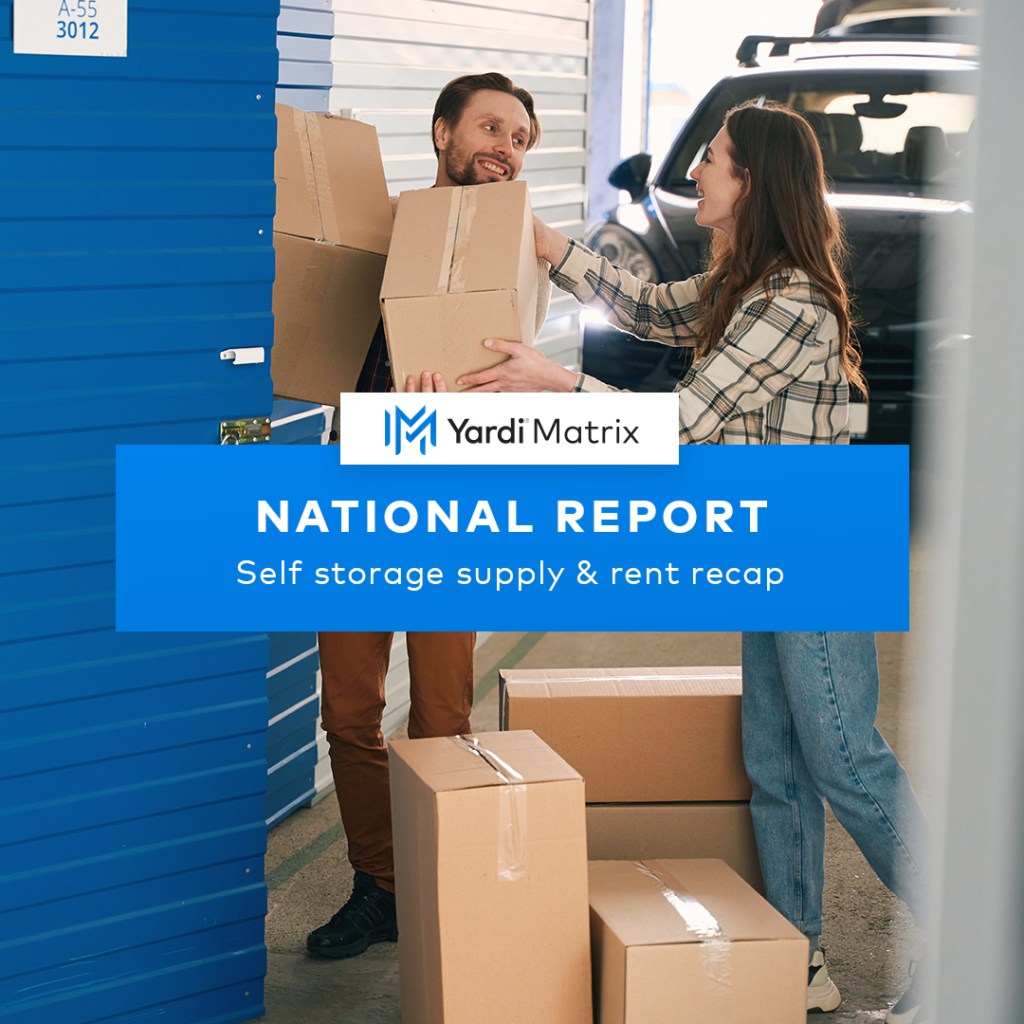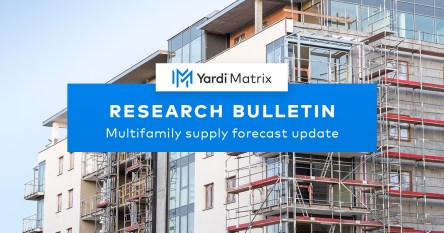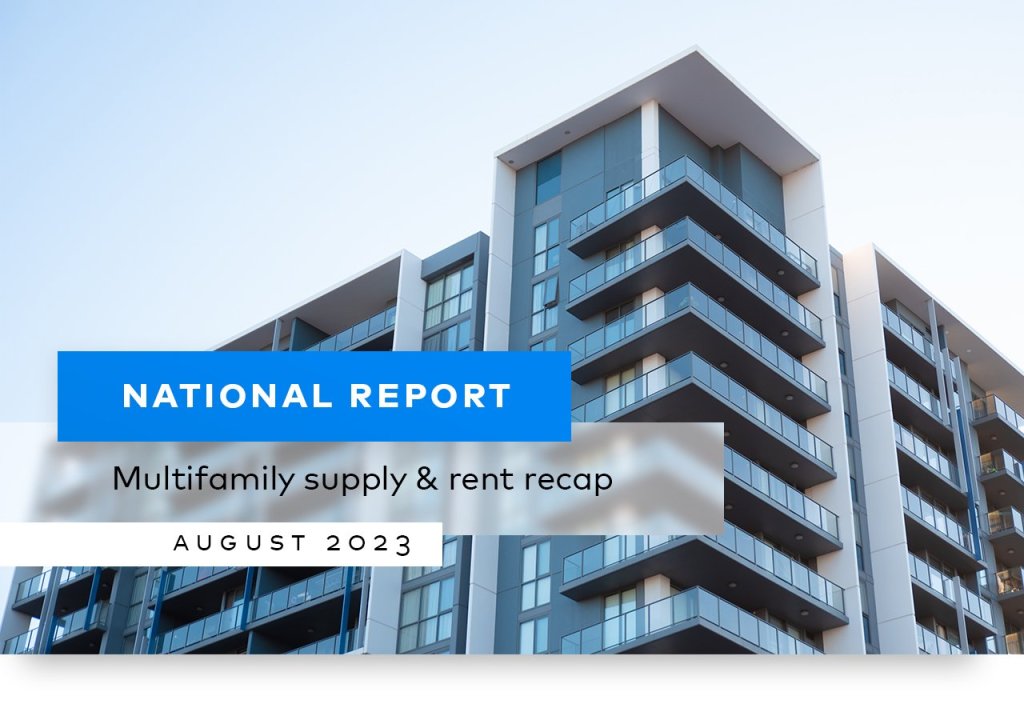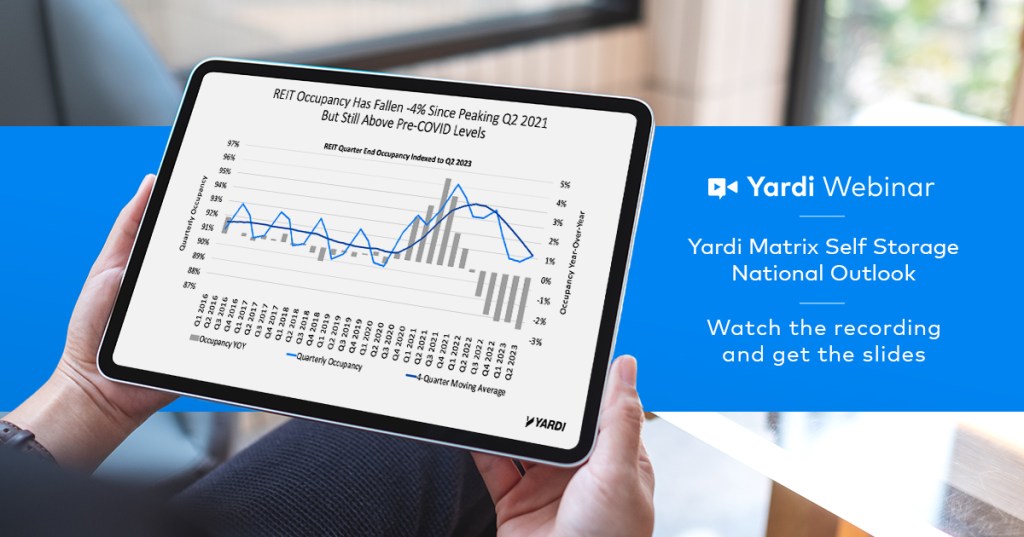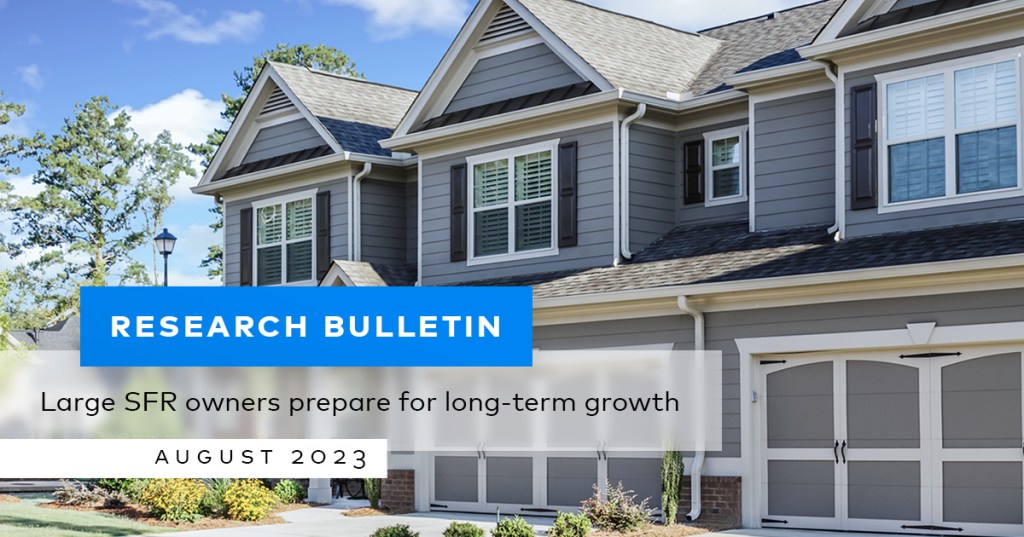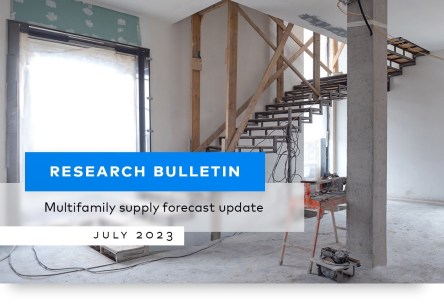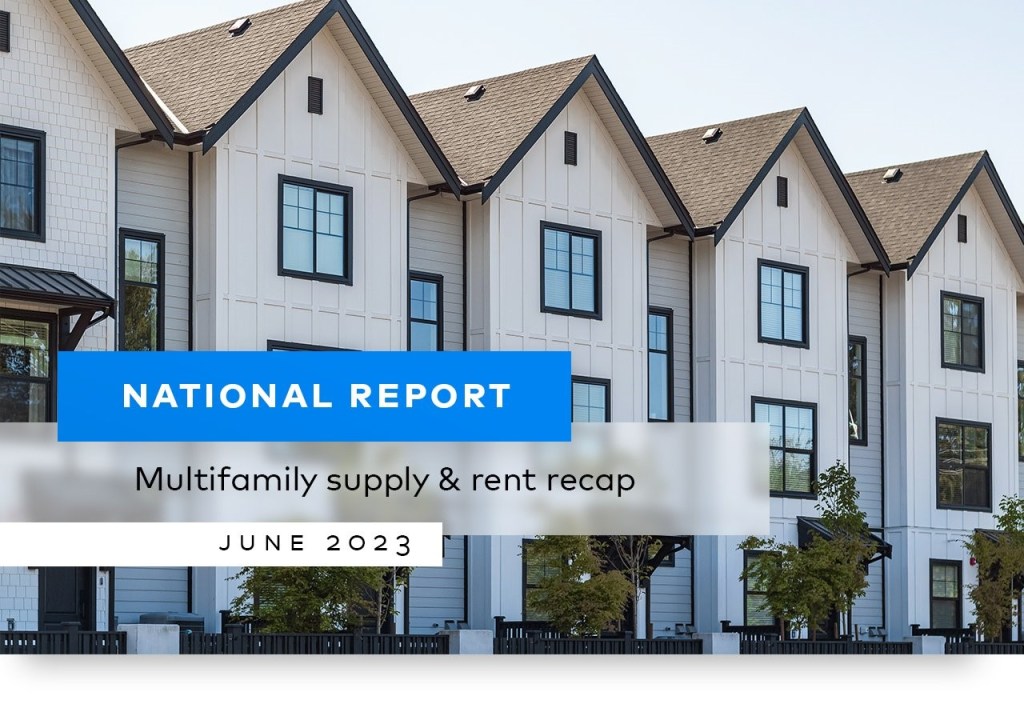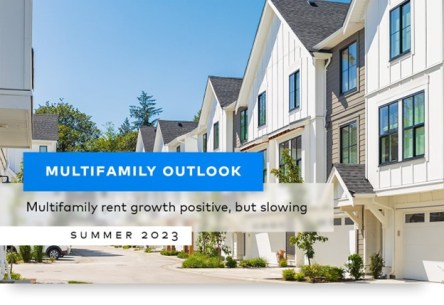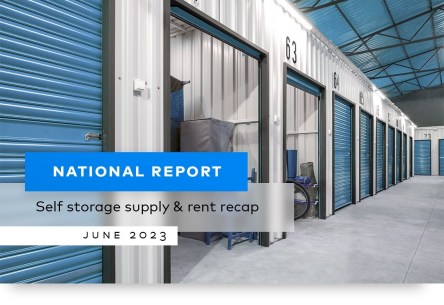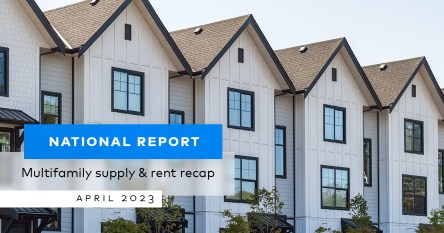National multifamily asking rent decreased for the third consecutive month in November, according to the latest Yardi Matrix National Multifamily Report. The average U.S. asking rent fell $6 to $1,713 in November, with year-over-year growth at 0.4 percent, on par with September. Occupancy remained steady at 94.9 percent since August. Metros in the Northeast and Midwest remained in the lead for rent growth, while Sunbelt and West metros lagged. More so, seven of Yardi Matrix’s top 30 markets were down 3.0 percent or more year-over-year, with the most significant rent declines registered in Sunbelt metros where developers delivered new supply in volume. “One could say the multifamily market is metaphorically hunkering down for the winter as property owners face the prospect of weak near-term rent growth due to inflation, the loosening job market and a surge in deliveries in some markets, while values and capital markets liquidity deteriorate as interest rates remain higher-for-longer,” states the report. Although rent growth was restrained in the middle of the last quarter of 2023, it posted a 23.5 percent increase since the start of the pandemic in March 2020. The current slowdown resulted from stock expansion in some areas and stretched affordability in other areas. Planned deliveries over the next two years will likely create some balance. Rents contracted across asset classes, steeper in the Lifestyle segment (down 0.4 percent) than in the Renter-by-Necessity segment (down 0.2 percent). Overall, monthly rent growth was negative in 25 of Yardi Matrix’s top 30 metros. Single-family rents fell $8 in November to $2,115, for a 0.7 percent year-over-year increase, down 30 basis points from October. Rent growth was solely sustained by the RBN segment, up 3.2 percent year-over-year, while Lifestyle rents declined 0.1 percent during the interval. Gain more insight in the...
Student Housing
Off and Leasing for Next Year
The fall semester may just be coming to a close, but preleasing for the 2024-2025 school year is already underway and off to a strong start, states the latest Yardi Matrix student housing report. Advance leasing for next school year started off extremely strong, reaching 25.2 percent for the Yardi 200 in October, well ahead of the previous record 10.4 percent preleased in October 2022. Preleasing this year is indicative of solid renewal activity early on and high demand for housing at many major universities, with 14 schools already more than 40 percent preleased. As for this year, final occupancy for the Yardi 200 markets for the fall 2023 semester settled at 94.6 percent in September 2023, compared to 96.2 percent in September 2022. Lower occupancy this year can be partly attributed to new properties that delivered late or struggled with preleasing. Properties that were completed in 2023 only reached 81.7 percent occupancy for the fall 2023 semester. Last month, average asking rent per bed was $854 among the Yardi 200 markets for the 2024- 2025 school year, slightly higher than where it ended the 2023 preleasing season in September 2023 and 6.6 percent higher than October 2022. “Some of the schools with the fastest preleasing are already seeing rents up 15-25 percent year-over-year, as operators take advantage of the surge in demand,” states the report. Read more findings from the latest student housing report. Yardi Matrix offers the industry’s most comprehensive market intelligence tool for investment professionals, equity investors, lenders and property managers who underwrite and manage investments in commercial real estate. Yardi Matrix covers multifamily, student housing, vacant land, industrial, office, retail and self storage property types. Email [email protected], call 480-663-1149 or visit yardimatrix.com to learn...
Demand Still Sluggish...
For Self Storage
Slowed demand for self storage continues to drive street rates lower, reports the new Self Storage National Report from Yardi Matrix. Annual street rate growth stayed negative in October. The average annualized same-store asking rate per square foot for the main unit types and sizes averaged $16.77 nationally last month, marking a 4.2 percent drop from the average recorded in October 2022. Street rates also remained negative on an annual basis in October in nearly all of the top metros. Combined same-store rates for non-climate-controlled units fell in all but one of the markets tracked by Matrix year over year, while asking rates for same-store climate-controlled units decreased in all of the top metros. “Elevated residential mortgage rates have slowed home sales, reducing population mobility, a major driver of storage demand. As a result, storage operators continue to lower asking rates to drive new rental demand,” states the report. In-place storage rents continue to trend upwards, supported by existing customer demand, helping bolster rental income for operators. In addition, the labor market remains relatively strong and inflation is slowing, which will benefit the sector as it helps boost the financial confidence of new and existing customers. Nationally, Yardi Matrix tracks a total of 5,006 self storage properties in various stages of development, including 864 under construction, 1,940 planned, 673 prospective, 1,457 abandoned and 72 deferred properties. Yardi Matrix also maintains operational profiles for 29,234 completed self storage facilities in the U.S., bringing the total data set to 34,240. Gain more insight on self storage performance. Yardi Matrix offers the industry’s most comprehensive market intelligence tool for investment professionals, equity investors, lenders and property managers who underwrite and manage investments in commercial real estate. Yardi Matrix covers multifamily, student housing, vacant land, industrial, office, retail and self storage...
Supply Forecast
From Yardi Matrix
Multifamily construction starts increased slightly in Q3 2023, and should have a positive impact on future deliveries, states the latest Multifamily Supply Forecast from Yardi Matrix. Construction starts remained relatively robust in the first half of 2023, and the under-construction pipeline increased 7.6 percent in the third quarter. As a result, the Q4 2023 supply forecast update has increased forecast completions 5.8 percent for 2024 and 6.2 percent for 2025. For multifamily markets tracked by Yardi Matrix, there are currently 1,223,601 units in the under-construction pipeline. Of these units, 479,634 are currently in lease-up, roughly in line with the trailing six-month average of 483,000 units but some 15.9 percent above year-ago levels. Most of these units will be completed this year or in the first half of 2024. Multifamily construction starts held at a relatively high level through the first half of 2023. As a result, the number of under-construction units not in lease-up continues to increase. Currently there are 743,967 units, a 16.2 percent quarterly increase and a 35.3 percent increase over year-ago levels. These units will most likely be completed in 2024 or 2025. Find more insights on forthcoming multifamily supply from Yardi Matrix. Yardi Matrix offers the industry’s most comprehensive market intelligence tool for investment professionals, equity investors, lenders and property managers who underwrite and manage investments in commercial real estate. Yardi Matrix covers multifamily, student housing, vacant land, industrial, office, retail and self storage property types. Email [email protected], call 480-663-1149 or visit yardimatrix.com to learn...
Student Housing Webinar
Matrix outlook remains positive
The Yardi Matrix team, including Jeff Adler and Tyson Huebner, delivered its final webinar of the 2023 year on the student housing sector’s performance and investment opportunities. If you missed it, you can view the recording and presentation slides here. Student housing maintained strong performance into the start of the 2023/2024 school year, though preleasing activity and rent growth showed some signs of slowing in the final weeks of leasing season. “The bottom line is that this sector compared to other sectors in the housing industry is looking very stellar. Good positioning, good rent growth – we don’t think (next year) will be quite as good as this year was, but still very strong,” said Adler, vice president of Yardi Matrix. “This is a great real estate segment and industry to be in, but picking the right schools is very critical to success.” Yardi Matrix has updated the schools whose housing is tracked in the Yardi 200, swapping out about 30 institutions less relevant to investors. The total tracked data set now includes 2,200 properties with 1.1 million beds. As of September 2023, 95.1 percent of beds at Yardi 200 universities were preleased, compared to 96.2 percent in September 2022. Lower preleasing in recent months can be partly attributed to slow lease-up of new 2023 deliveries, which were only 84.4 percent preleased in September. Rents are near an all-time high at $846 per bed, relatively unchanged in the past four months. Rent growth dropped to 6.1 percent in September, down from 6.5 percent in August and a peak of 7 percent in March 2023. But it is still well above previous years; it averaged 2.9 percent in September 2019, 2020, 2021 and 2022. (Read more findings from the latest student housing report here.) Student housing has seen a steep drop-off in transaction activity, which is attributed to ongoing strong performance and difficult financing conditions. But for owners and developers who completed new projects in time for fall leasing, rents were much higher than for existing properties. “New properties delivering this year had rents that were 29 percent above the national average,” said Huebner. Rents per bed for newly completed units averaged $1,088 as of September. “With continued rent growth in the sector and new supply coming at pretty high price points, I do think that will be an emerging investment opportunity when capital market conditions are ripe,” Adler said. He continued: “Everything’s a great place to put capital into; it’s a great place to participate. It does require an intense knowledge of each particular school and the sort of demand supply enrollment balances that make that all work.” Improve your market knowledge with a Yardi Matrix subscription: the industry’s most comprehensive market intelligence tool for investment professionals, equity investors, lenders and property managers who underwrite and manage investments in commercial real estate. Yardi Matrix covers multifamily, student housing, vacant land, industrial, office, retail and self storage property types. Email [email protected], call 480-663-1149 or visit yardimatrix.com to learn...
Matrix Assesses Multifamily Market
Webinar insights include economy, WFH, affordability and more
Yardi Matrix vice president Jeff Adler delivered an in-depth update on the state of the U.S. economy and the multifamily investment landscape last week, covering everything from inflation to recession risk to post-pandemic in-office trends. You can review the recording of the webinar and presentation materials here. Industry insiders know that these webinars are among the very best way to stay up to date on trends, performance and data. The next Matrix webinar will cover the outlook for the student housing sector on Oct. 25. You can sign up here. Among the key Yardi Matrix house view takeaways on the economy: U.S. economic growth is still strong, at 2.4 percent GDP growth in Q2 and strong early numbers for Q3 Inflationary pressures have started to cool, but remain elevated due to underlying price pressures Labor market is tight, but showing signs of softening “Inflationary pressures have been cooling, they remain a bit elevated, they are coming down. Maybe not as quickly as the Fed would hope,” Adler said. He still anticipates that a mild recession is on the way, likely landing in Q4 or the first half of 2024. “It’s a little hard for me to pinpoint exactly, but the process is pretty much played out, if not the exact timing of it.” Top line takeaways for those interested specifically in the multifamily sector: The market continues to outperform expectations, despite decelerating rent growth Regional market rotation is underway. Examples include slowing performance of Lifestyle units in the Sunbelt, due to increased supply, and outperformance in Midwest, Northeast and some Mountain metros This market rotation is due to affordability, which has become a primary focus for renters and pundits alike Supply shortage of U.S. housing is likely to be in place for the next decade “Rent growth has slowed down. We’re now looking at a tenth of a point in August over July,” Adler stated. Sequential rent growth is also very weak. While beneficial for multifamily operators, one of the sector’s greatest challenges is housing supply and affordability, which go hand in hand. “The housing deficit that built up from the Great Recession is still there. Regulatory costs account for 40 percent of multifamily development costs,” Adler noted. Some states, like California, Texas and Florida, but still have a long way to go. “If you really want to solve the problem, you got to have supply of all kinds. Where we have seen rents come down or decelerate, it’s been in markets with lots of supply,” he stated. One of the most interesting points shared in the webinar was how in-office work trends have played out over the last year. Data was delivered by Scoop. These metrics are relevant to the housing market because they determine how much flexibility workers have with where they live. Key takeaways included: The majority of U.S. companies, 61 percent, are allowing workers some in-office/remote flexibility The average in-office requirement time per week is currently 2.6 days Massachusetts, Oregon and Washington are the states with the most flexibility for remote work. The least flexible are Alabama, Kentucky and Arkansas Bottom line, rise in remote work has allowed workers to leave cities for more suburban areas, leading to declining population in some metros Want to gain all the great insight from Wednesday’s webinar? Find the recording of the webinar and presentation materials here and get...
Student Housing in Strong Spot
To start the 23/24 School Year
The student housing sector starts the school year in a strong position, as preleasing matches last year’s solid performance and year-over-year rent growth has continually outpaced 2022’s historic growth. Student housing is one of the few real estate sectors to be continually resilient post-pandemic, according to the latest National Student Housing Report from Yardi® Matrix, which is now available for download. You can also join the upcoming Student Housing Webinar with Matrix experts on Oct. 25 and gain more in-depth insight. As of August 2023, 94 percent of beds at Yardi 200 universities were preleased, a 3.3 percent increase from the prior month and 0.2 percent behind August 2022. Rents remained flat in August from July at $845 per bed, but year-over-year rent growth of 6.9 percent in August was still well above the historic average for the sector. “As we enter the 2023-2024 school year, student housing preleasing matches last year’s solid trend and year-over-year rent growth has continually outpaced last year’s historic growth, as well as other property sectors,” say Matrix analysts in the new report. “The sector is in prime position to weather a potential recession, with counter-cyclical demand patterns and solid occupancy and rent growth baked in for the 2023-2024 school year.” Strong fundamentals continue to fuel development, and Matrix projects approximately 40,000 new beds to deliver in fall 2023 at Yardi 200 universities, compared to the 27,000 delivered in fall 2022. Solid preleasing and rent growth suggest that much of the new supply has already been absorbed. Read more findings from the latest student housing report. The student housing data set includes over 2,000 universities and colleges nationwide, including the top 200 investment grade universities across all major collegiate conferences. Known as the “Yardi 200,” it includes all Power 5 conferences as well as Carnegie R1 and R2 universities. Yardi Matrix offers the industry’s most comprehensive market intelligence tool for investment professionals, equity investors, lenders and property managers who underwrite and manage investments in commercial real estate. Yardi Matrix covers multifamily, student housing, vacant land, industrial, office, retail and self storage property types. Email [email protected], call 480-663-1149 or visit yardimatrix.com to learn...
Multifamily Rent Update
From Yardi Matrix
Multifamily performance was stable in August, according to the latest Yardi Matrix National Multifamily Report. The average U.S. asking rent rose $1 to $1,728, while year-over-year growth fell to 1.5 percent, down 20 basis points from July. Occupancy was also effectively flat. “Economic growth continues to be stronger than expected, providing a backdrop to consistent multifamily demand. U.S. asking rents rose slightly in August, while occupancy rates remained strong at 95 percent,” states the report. These trends and much more will be discussed Sept. 20 in a multifamily-focused webinar with Matrix experts Jeff Adler and Paul Fiorilla. Sign up here to join live or receive the post-event recording. In the short term, supply remains a driving factor in rent growth. Most metros with the highest year-over-year asking rent growth, such as New York, Chicago, Indianapolis and San Diego, have weak new development pipelines. Single-family rents dropped back in August, down $6 nationally to $2,104. Year-over-year, national SFR rent growth fell 70 basis points to 0.5 percent. According to the report, some 190,000 multifamily units have been absorbed in the U.S. through July. That figure is below the record-setting year of almost 600,000 in 2021 but is otherwise a healthy pace. Among the top 30 Matrix metros, absorption in absolute numbers in 2023 has been led by Washington D.C., Phoenix, Miami, Chicago and Denver. As a percentage of stock, Charlotte, Tampa and Nashville are among the metros that have performed the best so far in 2023. Gain more insight in the new Yardi Matrix National Multifamily Report. Yardi Matrix offers the industry’s most comprehensive market intelligence tool for investment professionals, equity investors, lenders and property managers who underwrite and manage investments in commercial real estate. Yardi Matrix covers multifamily, student housing, industrial, office and self storage property types. Email [email protected], call (480) 663-1149 or visit yardimatrix.com to learn...
Weak Demand Hurts Self Storage
Yardi Matrix webinar recap
Self storage performance slumped in the second quarter of 2023, typically the strongest quarter, due to weak demand. That was among the top takeaways from a Thursday webinar hosted by industry leading data provider Yardi Matrix. You can view the webinar recording and presentation materials here. Among other key takeaways for the sector: Street rate growth continues to decelerate, as same store rates were down -4.6 percent in July One bright spot: operators were able to grow revenue by increasing existing customer rents (ECRI) The amount of new supply under construction Is moderating and likely won’t return to normal until 2025-2027 Investment activity is drastically reduced, with two notable exceptions (read on for details) “We’re in a kind of a 2017-2019 kind of world, where revenue growth is really off the back of ECRIs versus street rents,” said Jeff Adler, vice president of Yardi Matrix, during the webinar. Reasons that demand has dropped included the challenging single family real estate market, with interest rates for new purchases around 7 percent, and diminished mobility of American households post-pandemic. “Lower street rates are a result of weak move-in activity, with average REIT occupancy in Q2 2023 down 400 basis points from its all-time peak in Q2 2021,” states the latest self storage report. In July, overall national street rates (all unit sizes and types combined) dropped $1 to $141, down 0.7 percent month-over-month. Historically, rate growth is positive in July, averaging a sequential increase of 0.8 percent in the past seven years. While an anticipated recession has yet to fully materialize, Adler still expects that one will be in place by the end of the year, due to a lag time between Federal Reserve actions and the ultimate impact on the real economy. “We’re still in this period of time where you’re seeing strong economic growth, but we are seeing the beginning of the signs of a slowing trend,” Adler said. Self storage demand has historically been resilient, coming from a variety of sources, and growth rebounds quickly following a downturn due to month-to-month lease terms and flexible customer rate increase programs. But investor increased in the sector has also taken a hit in 2023, with two notable exceptions. Extra Space merged with competitor Life Storage in July. The combined company is now the largest storage operator in the country (based on the number of self-storage locations) with over 3,500 locations, approximately 270 million square feet of rentable storage space, and more than two million customers. Public Storage also announced last month that it has entered an agreement to acquire Simply Self Storage for $2.2 billion. According to the announcement: “The portfolio comprises 127 wholly-owned properties and 9 million net rentable square feet that are geographically diversified across 18 states and located in markets with population growth that has been approximately double the national average since 2018.” Aside from those significant moves, sales and M&A activity have plummeted, said Tyson Huebner, director of institutional research for Yardi Matrix. “It should be no surprise that transaction volume thus far this year has really fallen off the cliff. The number of properties sold in the first half of 2023, which doesn’t include those two portfolios, was down 56.6% from the first half of 2022,” Huebner said. Gain additional insights on self storage and the economy by checking out the entire...
Single-Family Rental Market
In Growth Mode
Although its pandemic-driven expansion has been tempered recently by rising mortgage rates and cooling home sales, the U.S. institutional single-family rentals (SFR) industry has entered a moderate growth mode that positions it “to thrive over the long term,” according to a new research bulletin from Yardi Matrix. Robust household family formation and elevated demand for family and home office space during the pandemic sparked a run-up of SFR rents, which increased by 27.9% from January 2020 to mid-year 2023. Occupancy rates have remained above 95% since January 2018. But rent increases slowed and year-over-year rent growth decelerated in the first half of 2023. The Federal Reserve has increased short-term interest rates by 525 points since spring 2022 and institutional SFR acquisitions have declined after two years of record volume. Despite this, “demand for single-family rentals is almost certain to remain firm,” with the sector having “solidified its presence as a niche segment of the overall commercial real estate market,” the bulletin says. The extent of the sector’s growth will depend on how well owners and investors succeed in financing acquisitions and developing efficient property management strategies. Nashville, Tenn., had the strongest year-over-year SFR rent growth at mid-year, followed by Baltimore and Chicago. The weakest metros for rent growth were Orlando, Fla., Miami and California’s Inland Empire. There’s much more insight into the SFR market in the August 2023 Yardi Matrix Bulletin, including an examination of fundamental drivers, a discussion of proposed legislation regarding institutional SFR purchases, a review of acquisition growth trends and reports on regional stock deliveries. Download your...
Street Rates Fall
Self Storage Update
Self storage street rates slipped month-over-month in July as demand and supply trends soften, according to the latest National Self Storage Report from Yardi Matrix. Street rate performance was weaker than normal in July. Nationally, overall street rates (all unit sizes and types combined) dropped $1 to $141, down 0.7 percent month-over-month. Historically, rate growth is positive in July, averaging a sequential increase of 0.8 percent in the past seven years. “Lower street rates are a result of weak move-in activity, with average REIT occupancy in Q2 2023 down 400 basis points from its all-time peak in Q2 2021. Demand is impacted by the weak home sales market and domestic migration coming down from pandemic highs,” state Matrix analysts. Street rates continued to be negative year-over-year in July in nearly all of Yardi Matrix’s top 31 metros. Rates for 10×10 non-climate-controlled units dropped in 30 of the top 31 metros compared to July 2022, while rates for similar-size climate-controlled units also decreased in all but one of the top markets (Pittsburgh). Despite the challenges, there are bright spots. The job market remains sound, and strong consumer balance sheets will support long-term demand. Self storage demand has historically been resilient, coming from a variety of sources, and growth rebounds quickly following a downturn due to month-to-month lease terms and flexible customer rate increase programs. Learn more about the state of the self storage sector nationwide. Yardi Matrix tracks a total of 4,916 self storage properties in various stages of development, including 830 under construction, 1,977 planned, 672 prospective, 1,375 abandoned and 62 deferred. Matrix also maintains operational profiles for 30,152 completed self storage facilities across the United States, bringing the total data set to 35,068. Yardi Matrix offers the industry’s most comprehensive market intelligence tool for...
Student Housing Updates now Monthly
Near-Record Preleasing in July
The student housing sector continues to outperform as the Fall 2023 school year approaches, according to the August National Student Housing Report from Yardi Matrix. Reports on national student housing performance, with insight on preleasing and rental rates, are now being delivered on a monthly basis. As of July, 90.1 percent of beds at Yardi 200 universities were preleased for the upcoming fall term, a 4.6 percent increase from the prior month and about even with last year. Preleasing was near a record high for July, and year-over-year rent growth throughout the leasing season has been ahead of last year. The sector is equipped to handle economic challenges, with solid occupancy and rent growth for the 2023-2024 school year and counter-cyclical demand. “Preleasing has slowed recently from rapid growth at the beginning of the leasing season. Month-over-month rent growth has also decelerated,” states the report. Despite the drop, fall occupancy is projected to match last year at around 96 percent, while rent growth remains impressive at 7.1 percent year-over-year. Strong fundamentals continue to fuel development, and Yardi Matrix projects approximately 40,000 new beds will be delivered in Fall 2023 at Yardi 200 universities, compared to 27,000 delivered last fall. Solid preleasing and rent growth suggests that much of the supply has already been absorbed. The student housing data set includes over 2,000 universities and colleges nationwide, including the top 200 investment grade universities across all major collegiate conferences. Known as the “Yardi 200,” it includes all Power 5 conferences as well as Carnegie R1 and R2 universities. Gain more insight in the latest Student Housing Report. Future reports will include a rotating special topic such as enrollment trends, transaction volume or development activity. Yardi Matrix covers multifamily, student housing, industrial, office, retail, vacant land and self storage property types. Email [email protected], call (480) 663-1149 or visit yardimatrix.com to learn...
Supply Forecast
Improves for Multifamily
The multifamily housing supply could increase to nearly seven percent by the end of 2023, states the latest Multifamily Supply Forecast from Yardi Matrix. The Q3 2023 supply forecast update has increased forecast completions 6.9 percent for 2023 and 6.5 percent for 2024. The near-term forecast was increased this month as the under-construction pipeline continues to expand, and 2023 construction starts to date have not exhibited any signs of a slowdown. For multifamily markets tracked on or before January 2020, there are currently just over 1.1M units under construction. Of these units, 429,626 are currently in lease-up, roughly in line with the trailing 12-month average of 421,000 units. Most of these units will complete in 2023 or the first half of 2024. As of this report’s release, Yardi Matrix is tracking 688,420 under-construction units that are not in lease-up. This represents a 36.9 percent year-over-year increase and a 96.7 percent increase over pre-pandemic levels. The longer-term supply forecast accounts for depressing completions in 2025 and 2026 relative to current levels, with a rebound taking hold in 2027. Forecast completions for 2026 have been reduced by five percent to 401,065, while forecast 2027 and 2028 completions have been reduced to 417,378 and 426,722 units, respectively. Review the latest Multifamily Supply Forecast here. Yardi Matrix offers the industry’s most comprehensive market intelligence tool for investment professionals, equity investors, lenders and property managers who underwrite and manage investments in commercial real estate. Yardi Matrix covers multifamily, student housing, industrial, office and self storage property types. Email [email protected], call (480) 663-1149 or visit yardimatrix.com to learn...
Self Storage Stalls
Yardi Matrix Reports
Responding to moderating demand, self storage street rates remained healthy through the second quarter of 2023, according to the latest National Self Storage Report from Yardi Matrix. Nationally, the average rate for self storage units overall remained unchanged month-over-month. Historically, rates tend to increase in the summer months. With the exception of 2019, every year from 2017 to 2022 experienced a May-to-June rent increase of at least 0.7 percent. “Muted monthly rate growth this year may signal that move-ins are slowing this leasing season as demand cools,” say Matrix analysts. “Move-in activity has slowed this year as home sales have cooled, especially compared to the robust home sales in early 2022.” In June, national street rates for 10×10 NON CC units decreased 3.8 percent year-over-year. Rates for 10×10 CC units fared worse, falling 5.3 percent year-over-year, the largest recorded decline since May 2020. Annual street rate growth continued to be negative for almost all of Yardi Matrix’s top 31 metros in June. Street rates for 10×10 NON CC units were down year-over-year in 97 percent of the top 31 metros. Learn more about the state of the self storage sector nationwide. Yardi Matrix tracks a total of 4,751 self storage properties in various stages of development, including 810 under construction, 1,913 planned, 622 prospective, 1,353 abandoned and 53 deferred. Matrix also maintains operational profiles for 29,824 completed self storage facilities across the United States, bringing the total data set to 34,575. Yardi Matrix offers the industry’s most comprehensive market intelligence tool for investment professionals, equity investors, lenders and property managers who underwrite and manage investments in commercial real estate. Yardi Matrix covers multifamily, student housing, industrial, office and self storage property types. Email [email protected], call (480) 663-1149 or visit yardimatrix.com to learn...
Forecast Adjusted
For Multifamily
Market corrections in Florida and California contributed to a month-over-month increase of average asking rents nationally by 41 basis points in May, states the latest Multifamily Forecast from Yardi Matrix. It was a decrease from the 44-basis-point MoM increase recorded in April and was prompted by actual decreases in asking rents in two regions: Florida markets that saw unbelievable growth during the pandemic and now face affordability problems, and California cities still struggling to find their post-pandemic footing. Five of the 10 worst-performing markets were in Florida (Southwest Florida Coast, Miami, Orlando, Jacksonville and West Palm Beach), and of the remaining markets that saw month-over-month declines, six were in California (metro Los Angeles, Sacramento, Eastern Los Angeles County, the East Bay, Orange County and the Inland Empire). Strong growth continues in many Midwestern and Northeastern markets: Portland, Maine, and Scranton–Wilkes-Barre both grew more than a full percentage point month-over-month. White Plains, Detroit, Urban and Suburban Chicago, Manhattan, Milwaukee, Rochester, Central New Jersey and Syracuse all saw asking rents grow more than 90 basis points from the previous month. The average apartment asking rent nationally was $1,726 in June, according to the Yardi Matrix National Multifamily Report. The update forecast lowers rent rate expectations for many larger markets in the West and Southwest and raises them for many midsize markets throughout the Midwest, Northeast and parts of the South. “The stalled-out return-to-office movement is putting a significant drag on Western markets with large numbers of knowledge-based workers, and economic uncertainty will continue to limit demand in those markets that have largely been driven by high-paying tech jobs,” states the report. As for those cities whose outlook improved: “As affordability continues to be a concern across the country and economic uncertainty prevails, these smaller markets will...
New Rent Record
For Student Housing
The student housing sector continues to record strong rent growth and preleasing performance is up slightly over 2022, according to the latest National Student Housing Report from Yardi Matrix. As of June, 86.6 percent of beds at Yardi 200 universities were preleased for the upcoming fall term, a 5.2 percent increase from the prior month. June also marked the fifth consecutive month of annual rent growth over seven percent at Yardi 200 universities, at 7.2 percent. Given that 2022 held the previous rent record for student housing, obtaining more than seven percent growth off of previous record-high numbers is exceptional. The average rent per bed at Yardi 200 universities was $846 at quarter-end, a new all-time record. “Under the surface of solid overall fundamentals at the Yardi 200 level is mixed performance at individual schools, as some universities are doing exceptionally well while others fall short. Performance at the university level is mainly correlated to local supply-and-demand dynamics rather than higher-level trends,” state Matrix analysts. The student housing data set includes over 2,000 universities and colleges nationwide, including the top 200 investment grade universities across all major collegiate conferences. Known as the “Yardi 200,” it includes all Power 5 conferences as well as Carnegie R1 and R2 universities. However, the sector isn’t totally unscathed by current economic conditions. Transaction volume through the second quarter was down about 73 percent from the same time last year, a stark reminder of weakening economic sentiment. But that hasn’t slowed the off-campus dedicated student housing development pipeline, which expanded by approximately 28,000 bedrooms since January. Gain more insight in the latest Student Housing Report. Yardi Matrix covers multifamily, student housing, industrial, office and self storage property types. Email [email protected], call (480) 663-1149 or visit yardimatrix.com to learn...
Multifamily Rent Update
From Yardi Matrix
Multifamily asking rents grew another $7 last month, on average, but year-over-year growth fell to 1.8 percent, according to the latest Yardi Matrix National Multifamily Report. That’s down 70 basis points from May. Rents are buoyed by ongoing strong demand for units. Though down from the 2021 highs, occupancy rates are steady at 95 percent. The average asking rent was $1,726 in June. “Rents are growing within a normal seasonal pattern, albeit well below the post-pandemic boom and even below pre-pandemic trends,” say analysts. Rents were up $20, or 1.2 percent, in the second quarter, and are up $23, or 1.4 percent, during the first half of 2023. Single-family rental rates increased $5 in June to $2,103, while year-over-year growth fell 80 basis points to 1.3 percent. “Demand has remained strong, driven by the job market, which added 1.5 million jobs during the first half of 2023, and weak home sales, which are presenting a challenge to first-time home buyers,” states the report. A growing number of metros are now posting negative growth year-over-year, states the report. Nine of the 30 metros tracked by Matrix were negative in June, mostly in the Sun Belt and West, where demand has reverted to normal as new supply comes online. This month’s report includes an updated list of metros that will be of interest to multifamily investors, owners and managers. Gain more insight in the new Yardi Matrix National Multifamily Report. Yardi Matrix offers the industry’s most comprehensive market intelligence tool for investment professionals, equity investors, lenders and property managers who underwrite and manage investments in commercial real estate. Yardi Matrix covers multifamily, student housing, industrial, office and self storage property types. Email [email protected], call (480) 663-1149 or visit yardimatrix.com to learn...
Multifamily Outlook
Insight from Yardi Matrix
Multifamily rents continued to increase through the first half of 2023, despite challenges for the sector and continuing economic uncertainty. But job growth has remained robust and new households keep forming, creating apartment demand and ongoing rent growth. “We anticipate that rents will continue to increase modestly over the course of the year as demand has firmed, albeit at a more moderate rate in line with historic growth levels,” say Yardi Matrix experts in a newly released U.S. Multifamily Outlook. Through the first five months of 2023, U.S. asking rents rose $17, or 0.9 percent, with year-over-year growth falling to 2.6 percent. “We expect continued deceleration, with rent growth of 2.5 percent for the full year,” states the outlook. The average U.S. apartment rent reached an all-time high of $1,716 in May. Challenges for the sector include slowing demand, growing issues with affordability, slower population growth and competition from a large number of new units coming online through 2024. The capital side of the industry has suffered due to heightened interest rates, which show little sign of decreasing in the near-term. Property values are down 15-20 percent from their peak and are still declining due to the higher cost of capital. New deliveries will be high at least through the end of 2024, as the 1 million units under construction come online. New starts are now declining, however, because debt is more expensive and fewer banks are financing construction. Household formation, which drove the 22 percent cumulative growth in U.S. asking rents over 2021 and 2022, has slowed but remains positive. Although some pandemic demographic trends are moderating, the desire for more space to balance living, working and family appears to have staying power and should continue to drive demand. Demand is also boosted...
Storage Rates Hold
Yardi Matrix Report
Self storage street rates were solid in May, with several unit types and sizes improving on a monthly basis and sequential growth staying to trend, according to the latest National Self Storage Report from Yardi Matrix. The self storage market continues to be resilient, despite headwinds to demand caused by a slowing housing market. National street rates for standard-size 10×10 non-climate-controlled (NON CC) units and 10×10 climate-controlled (CC) units both increased $1 month-over-month in May, to $128 and $143, respectively. Across all rate types tracked by Yardi Matrix, smaller-size units performed the strongest in May, as national rates for 5×5 units increased 1.8 percent for NON CC units and 1.7 percent for CC units on a monthly basis. Year-over-year, national street rates for 10×10 NON CC units decreased 3.8 percent, while rates for 10×10 CC units fell by 4.7 percent. Although year-over-year street rate growth has turned negative, net operating income continues to increase as operators push rates. That has come at the cost of a slight hit to occupancy rates, but demand is still above pre-pandemic levels. “The outlook for the sector remains optimistic, although concerns persist about how the slowdown in home sales and potential weakening job market caused by higher interest rates will impact storage demand, street rates and occupancy levels in the second half of 2023,” state Matrix experts. Learn more about the state of the self storage sector nationwide. Yardi Matrix tracks a total of 4,799 self storage properties nationwide in various stages of development — including 807 under construction, 1,959 planned and 646 prospective properties. Matrix also maintains operational profiles for 29,744 completed self storage facilities across the United States, bringing the total data set to 34,543. Yardi Matrix offers the industry’s most comprehensive market intelligence tool for investment...
Rents Rise in May
Multifamily Update
Multifamily asking rents rose for the third straight month in May, according to the latest National Multifamily Report from Yardi Matrix. Despite the threat of a slowing economy looming, average U.S. asking rent rose $7 in May to $1,716, while year-over-year growth decelerated to 2.6 percent. That was the lowest level since March 2021. For the year to date, rents are up $18, or one percent since January 1. The seasonal outline of growth is not far off a typical pre-pandemic year, although the rate of increase is lower. “While performance displays resilience, the data is not unambiguously positive as it has been for most of the last two years,” states the report. “Rent growth has turned negative year-over-year in several metros as occupancy rates weaken amid slackening demand and rapid growth in new deliveries.” Overall market attitudes remain positive. Renting is still cheaper than owning, and first-time buyers are renting longer. The stickiness of high-income renters likely contributes to the recent resurgence in high-end Lifestyle properties, in which rents rose 0.4 percent in May. The average single-family unit rent reached $2,100 for the first time in May, about a year after topping the $2,000 mark. Year-over-year growth fell 40 basis points to 2.1 percent. SFRs are boosted by waning home sales attributed to high interest rates and limited inventory. Gain more insights by downloading May’s Multifamily...
Remote Work Impact
On housing, communities and more
The impact of remote work on the housing market has been significant. In a webinar by Yardi Matrix, Jeff Adler, Matrix vice president, brought up several notable shifts. The full recording and presentation slides are available online. Let’s explore the big-picture impact of remote work on housing and communities. There are myriad cultural changes from the pandemic from an economic standpoint, but one of the most significant transitions is the prevalence of remote work. Working remotely offers more opportunities for household formation. In addition, with remote working becoming more prevalent, some employees are no longer tied to living near the offices. This has increased interest, particularly in suburban areas like Charlotte and Phoenix, where households can enjoy more space, lower living costs and a quieter lifestyle than in urban centers. Additionally, some businesses have chosen to leave high-cost cities for lower-cost ones, such as San Francisco to Austin, New York to the Carolinas and Chicago to Nashville. “I think Huntsville is a great market for many businesses, but it’s just now beginning to have a lot of supply hit,” said Adler. “Any place where you got to have a supply response will run through some struggles for the next couple of years as it gets absorbed.” In addition, research found that remote work has led to a surge in household formation, counterbalancing population loss in dense cities. First-time homebuyers are becoming priced out of the market, which encourages renting, especially while mortgage rates are at the highest level in more than 13 years. Household formation could stall as renters move in with family or roommates to cut costs. Remote work has given homeowners and renters more flexibility in choosing where to live. This has resulted in shifts in migration patterns. People are moving from...
Multifamily Trends
Yardi Matrix Webinar Recap
The U.S. multifamily sector faces complex challenges as the pandemic fades to a memory and a recession continues to loom for the U.S. economy later this year. Yardi Matrix vice president Jeff Adler dove deep into the market outlook and tough realities for operators during Thursday’s webinar. A full recording and presentation slides are available online. Current trendlines Matrix analysts have observed include: Multifamily fundamentals are generally strong, but continue to decelerate year-over-year A seasonal uptick in rents is ongoing and was reflected in reported data from March and April There is ongoing demand for renter-by-necessity communities, which have little new supply coming online Hybrid work has tilted household budgets towards housing expenses, rather than transportation A supply shortage in the U.S. housing market is likely to be ongoing for the next 5-10 years Inflation and interest rates continue to hamper transaction activity and will continue to do so for the near term The average U.S. asking rent rose $5 in April to $1,709, while year-over-year growth decelerated to 3.2 percent, down 80 basis points from March. (Gain more insights by downloading April’s Multifamily Report.) “Fundamentals have been pretty good, and we expected the deceleration (in rent growth). But there is a seasonal uptick happening – we did see that in April,” Adler said. “Affordability is still a key concern, and the political will to truly resolve the issue does not seem to be in evidence.” Consistent job growth and household formation over the last two years have continued to drive renter demand, despite lease renewal rates generally returning to pre-pandemic levels. In some cases, renters are seeking creative alternatives to hard-to-find housing, such as co-living situations, using short term rentals as permanent homes, or even subletting vacation rentals. But these aren’t long-term solutions, and ultimately new housing development will have to be the answer. “It’s important to note the historic increase in rents that occurred in 2021. There was a need for wages to catch up .. But when we look at the cost of housing to buy, it is still way more expensive compared to renting. Renting is still a viable and preferable economical alternative, including single family rentals and built-to-rent homes,” Adler said. In conjunction with a slowdown in construction financing due to banking sector instability, the upshot is that the supply shortage for multifamily housing will be exacerbated, potentially lasting up to a decade unless government bodies change their tune. If you’re looking for investment windows despite those challenges, be sure to review the webinar recording, which offers insight into target opportunity...
RE Trends Emerge
In Annual Report
The 44th edition of one of the real estate industry’s most closely followed reports is out, offering a sweeping look at conditions in the U.S. and Canadian property management and investment arenas. 2023 Emerging Trends in Real Estate, an annual collaboration between PwC and The Urban Institute, reports that amid rising interest rates and some signs of economic distress, most professionals contributing to this year’s report remain “reasonably upbeat” about longer-term prospects. Here are some key trends outlined in the report, which incorporates input from several hundred experts including Peter Kolaczynski of Yardi Matrix: Vertical markets such as residential and industrial could weaken due to diminishing pandemic tailwinds and the potential for a cyclical economic downturn, while others – including hotels and retail – might heat up. Some pandemic-driven structural shifts remain. Online spending, for example, is receding from its pandemic peaks but probably won’t revert to pre-pandemic levels. The same is true of business travel, with the lodging, dining and convention facility sectors facing challenges for the foreseeable future. Although real estate sales volume in the first half of 2022 was 38% higher than over the same period last year, capital is still heading to the sidelines or to other assets. “The recent surge may well reflect a last gasp to get deals done before the expected increase in interest rates” that would make acquisitions and construction debt more expensive, Emerging Trends says. Housing affordability has fallen to its lowest level in over 30 years, with prices, mortgage rates and rents soaring relative to incomes. With “a growing share of households priced out of the for-sale market, demand for rental units is far outstripping new supply,” the report says, with the growing number of younger adults choosing to live alone also a factor....
Rents Rise Again
Multifamily Market Update
Multifamily asking rents rose for the second straight month in April, according to the new National Multifamily Report from Yardi Matrix. Despite economic headwinds, the market continues to demonstrate resilience. The average U.S. asking rent rose $5 in April to $1,709, while year-over-year growth decelerated to 3.2 percent, down 80 basis points from March. Solid demand has kept rents rising, but at a slower rate than previous years. Demand is buoyed by a tight job market and healthy household budgets, although economists are scrutinizing how much longer those conditions will persist. A recession is still forecast for later this year. “Rent growth is broadly positive nationally, but regional differences are emerging. High-demand Sun Belt metros are feeling the impact of reduced affordability and robust deliveries, while primary metros have less supply growth and some benefit from rebounding immigration,” states the new report. Multifamily rent gains remain positive year-over-year everywhere but Phoenix and Las Vegas, but the top-performing markets are different each month. In April, Indianapolis (7.7 percent) and Kansas City (6.4 percent) led the top 30 Matrix metros in rent growth, while primary metros New York, Boston and Chicago round out the top five. Single-family unit rents also hit a new all-time high in April, averaging $2,089, but year-over-year rates once again decelerated, dropping 60 basis points to 2.3 percent. Occupancy rates decreased in March to 95.5 percent but have stabilized after peaking at 97 percent in 2021. Gain more insights by downloading April’s Multifamily Report. Yardi Matrix offers the industry’s most comprehensive market intelligence tool for investment professionals, equity investors, lenders and property managers who underwrite and manage investments in commercial real estate. Yardi Matrix covers multifamily, student housing, industrial, office and self storage property types. Email [email protected], call (480) 663-1149 or visit yardimatrix.com to learn...
Student Housing Stands Out
Yardi Matrix Webinar Recap
As the student housing sector continues to outperform other real estate classes during a time of economic uncertainty, tailwinds from the multifamily market and consolidation of the higher education landscape are driving strong performance. Those were two key takeaways from the latest Yardi Matrix market update, which took place this week and featured insights from Jeff Adler, vice president of Yardi Matrix, and Ron Brock, industry principal. If you missed the webinar, a session recording and the presentation deck is available now. Student housing demonstrated record preleasing as of March, with rent growth averaging 7 percent across all university types tracked by Matrix. Less expensive unit types, such as 3-bedrooms, are picking up a higher share of the preleasing inventory, indicating that more students than ever are returning to campus post-pandemic. “From an operations standpoint, preleasing season has crushed it this year,” Adler stated. “Fundamentals seem to be tied to increasing enrollment at the most competitive schools, which are the winners in the ongoing consolidation of the higher education system.” The Yardi Matrix student housing data set includes over 1.3 million beds at 2,500 universities and colleges nationwide, including the top 200 investment grade universities across all major collegiate conferences. Known as the “Yardi 200,” it includes all Power 5 conferences as well as Carnegie R1 and R2 universities. The top 50 largest universities are forecasted to have the most enrollment growth over the next five years, confirming consolidation of the higher education space. Adler began forecasting the anticipated consolidation in a Fall 2021 webinar and the trend continues to evolve, but is reflected in high demand for preleasing at colleges in urban areas and with multifamily shadow markets. In a notable demonstration of the trend, Southeastern Conference (SEC) schools logged the most annual rent growth of any Yardi 200 conference at 11 percent. “This is influenced by significant run ups in rents in the conventional multifamily sector – in and around the cities where the SEC schools are located,” noted Adler. “The tailwind coming from the multifamily sector has a significant effect on operating results.” That includes schools like the University of Arkansas, University of Mississippi and University of Tennessee, which were among the top performers for rent growth and preleasing growth over the last quarter. Other key takeaways from the presentation included: Deliveries of new student housing stock dipped in 2022 but are expected to rebound this year. Transaction activity has slowed due to higher interest rates. Investors backed off of purchases dramatically in Q1 2023, with only $148 million in sales completed, down substantially from the $1.5 billion recorded in the first quarter of 2022. Significant development and transaction activity may not take place until 2025/2026 after the economy improves and interest rates are lower. California is not the only state experiencing significant shortages in student housing. That’s also taking place in Florida (Florida Atlantic University, Florida A&M), at the University of Arkansas, the University of Tennessee and the University of Cincinnati. Florida is a hot spot for student housing development, with over 12,000 bedrooms under construction around four universities. Bottom line, the student housing sector is one of the hospitable places for investors these days, even with the economy in flux. “Student housing is in the best position compared to other real estate asset types because of continued high performance,” Adler said. “There are multiple paths for investment in student housing, there isn’t just one way to succeed.” Learn more about the student housing market conditions from the latest Yardi Matrix National Student Housing report, released...

